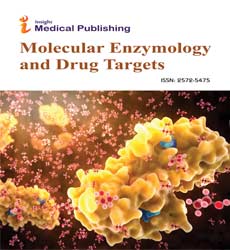Abstract
Pharma-2012 : Preparation of BSA nanoparticles by desolvation technique using ethyl alcohol as desolvating agent - A.Krishna Sailaja - Osmania University
In order to see functionality and toxicity of nanoparticles in various food and drug applications, it is important to establish procedures to prepare nanoparticles of a controlled size. Desolvation, a thermodynamically driven self-assembly process for polymeric materials.Here BSA nanoparticles were prepared by desolvation technique using Ethyl alcohol as desolvating agent. In our study, Ethyl alcohol was added intermittently into 1% BSA solution under stirring at 700 rpm. Amount of Ethanol added, intermittent timeline of Ethanol addition, and pH of solution were considered as process parameters to be optimized. Effect of the process parameters on size of the nanoparticles were studied. The results indicated that the size control of BSA nanoparticle was achieved by adding Ethanol intermittently. The standard deviation of average size of BSA nanoparticles at each preparation condition was minimized by adding Ethanol intermittently. Particle size of BSA nanoparticles prepared by continuous addition of Ethyl alcohol as desolvating agent was in between 200-300nm.Whereas uniform particle size was obtained by adding Ethyl alcohol intermittently. The particle size was found to be in between 180-220nm.FTIR spectra Indicates that there was no drug and polymer interaction. A nanoparticle or ultrafine particle is typically defined as a particle of matter that's between 1 and 100 nanometres in diameter. The term is usually used for larger particles, up to 500 nm, or fibers and tubes that are but 100 nm in just two directions. Nanoparticles are now bOut of three human studies, just one showed a passage of inhaled nanoparticles into the bloodstream. Materials which by themselves aren't very harmful might be toxic if they're inhaled within the sort of nanoparticles. The consequences of inhaled nanoparticles within the body may include lung inflammation and heart problems. Getting used within the manufacture of scratchproof eyeglasses, crack- resistant paints, and anti-graffiti coatings for walls, transparent sunscreens, stain-repellent fabrics, self-cleaning windows and ceramic coatings for solar cells. Nanoparticles are now getting used within the manufacture of scratchproof eyeglasses, crack- resistant paints, and anti-graffiti coatings for walls, transparent sunscreens, stain-repellent fabrics, self-cleaning windows and ceramic coatings for solar cells. Nanoparticles called AuroShells absorb infrared from a laser, turning the sunshine into heat. The corporate developing this system is named Nanospectra. Targeted heat therapy is being developed to destroy carcinoma tumors. Safety of Nanoparticles. Current research indicates that exposure via inhalation and skin contact may result in nanoparticles entering the body. Nanoparticles are tiny particles which will be inhaled or ingested and should pose a possible problem both medically and environmentally. A nanoparticle or ultrafine particle is typically defined as a particle of matter that's between 1 and 100 nanometres (nm) in diameter. Nanoparticles also easily undergo common filters, like common ceramic candles. In order that separation from liquids requires special nanofiltration techniques. Free nanoparticles are formed through either the breaking down of larger particles or by controlled assembly processes. Natural phenomena and lots of human industrial and domestic activities, like cooking, manufacturing or road and air transportation release nanoparticles into the atmosphere. Nanoparticles often have unexpected visible properties because they're sufficiently small to confine their electrons and produce quantum effects. For instance gold nanoparticles appear crimson to black in solution. The massive area to volume ratio also reduces the incipient melting temperature of nanoparticles. Nanoparticles and their Applications. This is often typically because nanoparticles have a greater area per weight than larger particles which causes them to be more reactive to another molecules. Nanoparticles are used, or being evaluated to be used, in many fields. Cancer nanotechnology may be a branch of nanotechnology concerned with the appliance of both nanomaterials (such as nanoparticles for tumour imaging or drug delivery) and nanotechnology approaches (such as nanoparticle-based theranostics) to the diagnosis and treatment of cancer. Lung damage is that the chief human toxicity concern surrounding nanotechnology, with studies showing that the majority nanoparticles migrate to the lungs. However, there also are worries over the potential for damage to other organs. The ideas and ideas behind nanoscience and nanotechnology started with an interview entitled “There's many Room at the Bottom” by physicist Feynman at an American Physical Society meeting at the California Institute of Technology (CalTech) on December 29, 1959, long before the term nanotechnology was used. Natural sources of nanoparticles include combustion products forest fires, volcanic ash, ocean spray, and therefore the decay of radon gas. Natural nanomaterials also can be formed through weathering processes of metal- or anion-containing rocks, also as at acid mine drainage sites. Targeted cancer nanotherapy. Yet, the main challenge remains in targeting and selectively killing cancer cells while affecting as few healthy cells as possible. Nanometer-sized particles have novel optical, electronic, and structural properties that aren't available from either individual molecules or bulk solids. Nanoparticles are now getting used within the manufacture of scratchproof eyeglasses, crack- resistant paints and anti-graffiti coatings for walls, transparent sunscreens, stain-repellent fabrics, self-cleaning windows and ceramic coatings for solar cells. Being much smaller than the wavelengths of light (400-700 nm), nanoparticles can't be seen with ordinary optical microscopes, requiring the utilization of electron microscopes. Nanoparticles have the potential to cross the blood brain barrier, which makes them extremely useful as how to deliver drugs on to the brain. On the opposite hand, this is often also a serious drawback because nanoparticles wont to carry drugs could also be toxic to the brain.
Author(s):
A.Krishna Sailaja and P. Amareshwar
Abstract | PDF
Share this

Abstracted/Indexed in
- Google Scholar
- China National Knowledge Infrastructure (CNKI)
- Publons
- Secret Search Engine Labs
Open Access Journals
- Aquaculture & Veterinary Science
- Chemistry & Chemical Sciences
- Clinical Sciences
- Engineering
- General Science
- Genetics & Molecular Biology
- Health Care & Nursing
- Immunology & Microbiology
- Materials Science
- Mathematics & Physics
- Medical Sciences
- Neurology & Psychiatry
- Oncology & Cancer Science
- Pharmaceutical Sciences
